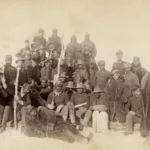Black Wall Street: A Story of Resilience and Triumph
More News /Article
O.W. Gurley, second from left in the bottom row, around 1921. (Tulsa Historical Society and Museum)
Black Wall Street, a term used to describe the affluent African American community in Tulsa, Oklahoma’s Greenwood District, stands as both a symbol of the economic potential of Black communities and a reminder of the systemic challenges they have faced. In the early 20th century, Greenwood was a thriving hub of Black-owned businesses, cultural institutions, and self-sufficiency, showcasing the remarkable resilience and ingenuity of its residents despite the harsh realities of segregation and racism in America.
Origins of Greenwood
In the early 1900s, African Americans seeking opportunity and refuge from the pervasive racism of the Jim Crow South began settling in the Greenwood District of Tulsa. O.W. Gurley, a visionary Black entrepreneur, purchased 40 acres of land in the area and sold plots exclusively to Black settlers. This provided the foundation for a flourishing community, often referred to as Black Wall Street due to its wealth and success.
By the 1920s, Greenwood had developed into a bustling economic and cultural epicenter. The district boasted over 600 businesses, including grocery stores, theaters, restaurants, and medical practices. Many residents owned their homes, and educational institutions flourished, creating a vibrant and self-sustaining ecosystem.
A Model of Black Excellence
The prosperity of Greenwood was a testament to the determination and entrepreneurial spirit of its residents. Prominent businesses like the Stratford Hotel, one of the largest Black-owned hotels in the country, and the Dreamland Theatre, a cultural landmark, exemplified the community’s success. The district’s economy operated almost entirely within the Black community, providing a model of collective wealth-building and economic empowerment.

The 1921 Tulsa Race Massacre
Greenwood’s prosperity, however, became a target for white resentment and violence. On May 31, 1921, an accusation against a young Black man, Dick Rowland, led to a confrontation that escalated into one of the most devastating acts of racial violence in U.S. history. Over the course of 18 hours, white mobs attacked Greenwood, looting and burning homes and businesses. An estimated 300 people were killed, thousands were left homeless, and the district was reduced to ashes.
The massacre decimated Black Wall Street, leaving a scar that would take decades to heal. Survivors received no justice, and efforts to rebuild faced immense challenges due to systemic discrimination and lack of support. Despite this, many residents worked tirelessly to rebuild their community, demonstrating extraordinary resilience in the face of unimaginable loss.
Lessons and Legacy
The story of Black Wall Street is one of tragedy and triumph. While the Tulsa Race Massacre remains a painful chapter in American history, the legacy of Greenwood is a powerful reminder of what Black communities can achieve when given the opportunity. Today, efforts to honor and preserve this history have gained momentum, with initiatives such as the Greenwood Rising history center and educational programs ensuring that the lessons of Black Wall Street are not forgotten.
Black Wall Street continues to inspire conversations about racial equity, economic empowerment, and the importance of preserving African American history. It serves as both a cautionary tale and a beacon of hope, reminding us of the potential for greatness even in the face of adversity.
More News /Article






